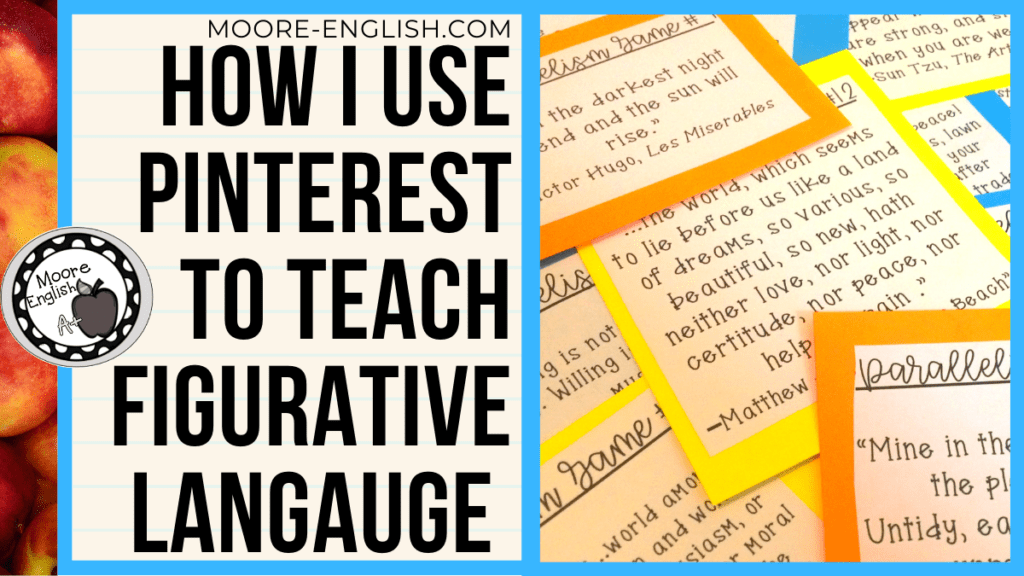Over the years, I’ve tried different methods to help students learn about figurative language and literary devices. I was always taught figurative language through lecture: a teacher defined a term, talked about it, and gave an example. Sometimes I would remember the term. But most of the time, I did not truly retain or learn the information. Because we tend to teach how we were taught, when I first started teaching, I gave lectures and notes, too. But I found that my students, like me before, were not really retaining the material or making it their own.
So I made a change with my approach to teaching figurative language. I’ve done different versions of this activity, but this one is my favorite.
This post this post may contain affiliate links. Please read the Terms of Use.
Preparing to Teach Figurative Language
First, decide which figurative language or literary device you want to teach. I’ve found that my students usually come knowing simile, metaphor, hyperbole, alliteration, and personification but have never heard of parallelism, irony, or connotation. In my state, the End of Course exam always includes questions about parallelism. So it’s important for students to become comfortable with recognizing, analyzing the effects of, and using parallelism. So that’s where I began.
Then, collect a series of examples of the figurative language or literary device you’d like to teach. I’ve collected all of my examples on Pinterest on the board Parallelism/Parallel Structure. You could also collect examples in hard copy or in a Collaborative Google Slides.
Regardless of how you collect examples, you want your students to be able to access all your examples simultaneously. I’d also suggest a variety of examples. Avoid simplistic examples because then the activity is too easy. Also avoid providing too many examples because that can be overwhelming.

Teaching Figurative Language
Then, group students into 3-4 and explain how they should access the images. My students just login to Pinterest with their school Google accounts (Pinterest is not blocked at my school).
Next, explain to students that each image is an example of whatever figurative language or literary device you’re teaching. In my case, I’d explain that each image is an example of parallelism or parallel structure. Ask students to work backwards to find and create a group definition of your figurative or literary device. In my case, I challenge students to define parallelism or parallel structure.
As students work, I walk around and listen in to their discussions, offering redirection and suggestions. When a group thinks they have a definition, they raise their hand. Then I make suggestions or ask them questions. Rarely do I have a group come up with the definition on the first try. Usually their definitions are too broad or too narrow.
When a group has a definition that is correct, I ask them to find more examples and add them to the class board. This is why I really like to use Pinterest. All I have to do is add a student to the board as a collaborator. Then they can edit the board so long as they keep their pins school appropriate. This also means the board remains accessible for students for the rest of the year.
I do this activity 2-3 times during the year. In the past, I’ve done parallelism and allusion. And this year I’m adding aphorism. Since we do this several times, the boards all remain in one place. And students can visit them as needed.
Providing Closure
The entire activity takes 20-30 minutes depending on my group of students. When each group is finished, we look at 4-5 pins, noting the parallel features and reviewing any other figurative or literary devices we see. This works as a good opportunity to discuss how a writer or speaker can use multiple devices simultaneously to create a specific effect.
You might be wondering why students don’t just Google the definition of parallelism or whatever figurative device. In five years of doing this activity, I’ve only ever had 2 students go this route. Most students prefer the competitive nature of the “game” and buy in accordingly.
If you don’t want to mess with technology, I have several paper-based activities you can use:
- Figurative Language Task Cards (part of this bundle)
- Rhetoric Card Sort and Task Cards
- What is Irony? Listening Guides
- Literary Devices BINGO
- Point of View Gap Fill
Let me know how you teach figurative language and literary devices below. Are there specific devices you’re struggling with? Additional boards you’d like me to create? Let me know in the comments!








